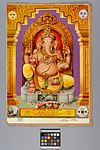About this object
History of use
Indian popular religious prints have been published for nearly a century, first by German presses, later by Indian ones. The prints may take the form of calendars, posters, or simply images. The style of the representations is European. In the beginning they were Hindu images, but are now acquiring elements both of folk art and a romantic secularism. It is a living art currently influenced by the movie industry and non-Hindu religions. The images are a vehicle for advertising and are also used for religious purposes. This print was produced, framed, and displayed in a prayer room for 'puja' or worship.
Cultural context
popular religious art
Iconographic meaning
Ganesh, remover of obstacles, god of wisdom, protection, and guidance, and son of Shiva and Parvati, is identified by: elephant head; rat as vehicle, permitting Ganesh to remove obstacles where small size is needed; obesity containing entire universe; pot belly indicating prosperity in enterprise; three bands of ash or red trident as third eye, symbolizing relationship with Shiva; rice or sweet cakes, axe, noose, string of beads, and/or water vessel held in hands; water jar held by trunk; and swastika in palm to symbolize cyclical time. Print on back: attributes indicating Vishnu are 'u' on forehead and symbols he carries: white conch shell associated with the origin of existence, and the wheel or disc representing the power of creation and destruction, and the universal mind. With him is Lakshmi, his female counterpart whom he is nearly always seen holding with one arm. She holds lotus flowers, symbols of wealth, and is associated with beauty, virtuousness and agriculture. Together, these deities represent divine substance: Vishnu symbolizes eternity, and Lakshmi the tendency to create. Smallest print on back:
Physical description
Main print: four-armed, elephant-headed figure (Ganesh) with large paunch sits on grey plinth-like stone platform with a tall, arched, red-cushioned, gold backrest; inset on the lower front is a crouched rat. Male's leg on right folded into body; foot on left flat on floor, leg bent. Wears yellow dhoti, gold crown, jewelry, and gold snake at waist. Food and flower offerings on plate in front of him. Holds four objects, one in each hand: portion of one of his two white tusks, two gold sceptre-like objects, and white shell(?). Purple background. Male seated under ornately sculpted gold arch supported by two gold columns, moon on one side, sun on other, both with facial features. Print glued onto rectangular, brown sheet of paper. Two smaller prints are glued to the back. The larger of the two shows a standing four-armed woman wearing a white and gold sari and gold necklace. She holds lotus flowers in upper hand on right, and gold teapot in lower hand on left. Behind and to the left of her stands a four-armed blue-skinned man with red 'u' on his forehead, and wearing a gold headdress, pink shawl, and white garland around his neck. His upper hand on left holds a disc, hand on right holds conch shell; lower hand on left in upturned position, lower hand on right behind woman, not visible. Background is blue, with five large cobras in yellow-white halo, spread in fan shape over the man and woman. The signature on bottom left is 'Mulgaoker Art Studio.' The smaller print on the back is of a dark-haired female in a red and gold sari with a veil under one arm standing in front of a male dressed in white cloth pants; two streaming wraps, red one over shoulder, white one from waist; and wearing red and gold crown. With right hand he holds a large round container above female's head. Hand on left holds other end of female's veil. Female raises hand on left to support container over her head. Background is swirled green landscape. Indian script stamped, upper right. All colours subdued.
